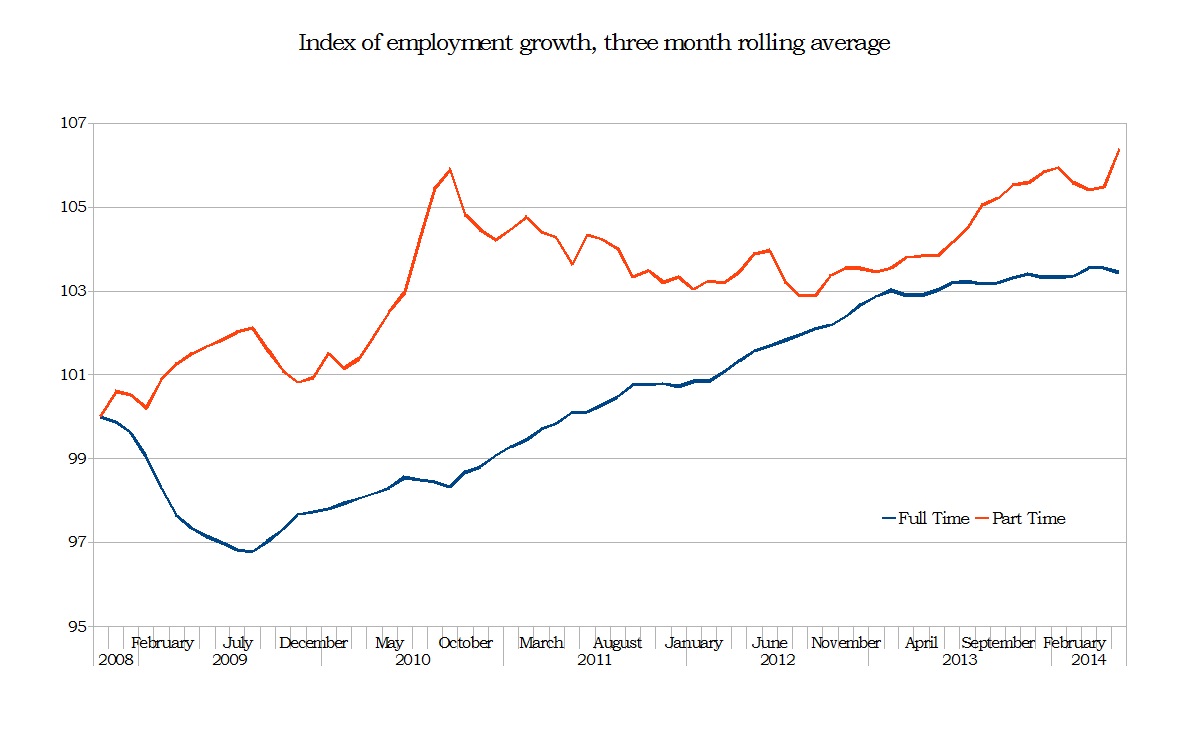Labour market stagnant
Erin has already commented that the tiny silver lining of 26,000 net new jobs in May covers a net loss of full-time jobs. In fact, if you compare this May to May 2013, we see that all of the net job gain in the past 12 months is part-time work too.
To look at the trends, I broke down employment growth since October 2008 into part-time and full-time jobs. This shows that full-time job growth has been pretty much stagnant since January 2013.
While we expect to see stronger growth in part time work earlier in a recovery, here we see the growth of part-time work accelerating again – over four years after the beginning of the recession.
The number of underemployed part-time workers (working part-time, wanting full-time hours) has remained elevated since the beginning of this recession. You can see from the graph that there was some easing in 2012, but with the recent increase in part-time work, the trend is moving upwards again.
This May there were over 1 million underemployed part-time workers in Canada, and a total of 2.9 million unemployed and underemployed workers (not seasonally adjusted). Nearly 1 million of those workers were under the age of 24.
Ontario workers, in particular, are having a hard time. The underemployment rate for Ontario (not seasonally adjusted) was 16.6% in May – 2 percentage points higher than the national average. That represents 550,000 unemployed and 735,000 underemployed Ontario workers.
And Tim Hudak plans to fix that by firing 100,000 public sector workers. I think we need a better plan.



The G&M reports today June 9th on Joe Oliver’s remarks to the effect that two of Canada’s major provinces, Quebec and Ontario, are in danger of having their debt ratings downgraded due to high debt levels.
This comment sounds as if it is intended to help promote Hudak’s platform.
Would it be possible for one of the PEF economists to examine the issue of federal downloading and the way in which this has negatively impacted provincial and civic finances?
My memory is that this downloading commenced with Chretien, and was further advanced by the Harris government. Chretien downloaded to the provinces and “leaders” such as Harris turned around and downloaded to the cities. Federal and Provincial tax rates stayed the same but urban centers boosted property tax rates and this gave us media events such as the Ford administration.
A second outcome is that while the Federal government collects the majority of income, it has cut, and proposes to continue to cut, transfers to the provinces. This results in fiscal improvements at the Federal level and gives a “leader” like Joe Oliver ammunition to complain about the behaviour of the very persons he has short shrifted.
Plus the people at the bottom of the pyramid are very conscious of the fact that they are paying for the indexed pensions of civil servants when they are unable to save anything to provide for their own retirement.
Oliver’s recommendation for a provincial austerity program, if enacted, will likely increase the “politics of resentment” and increase the numbers who vote for right wing “austerity solutions” such as $35 billion for a fighter plane that is unlikely to meet Canadian requirements.
Is this analysis correct? Can the economists confirm?
Thanks.